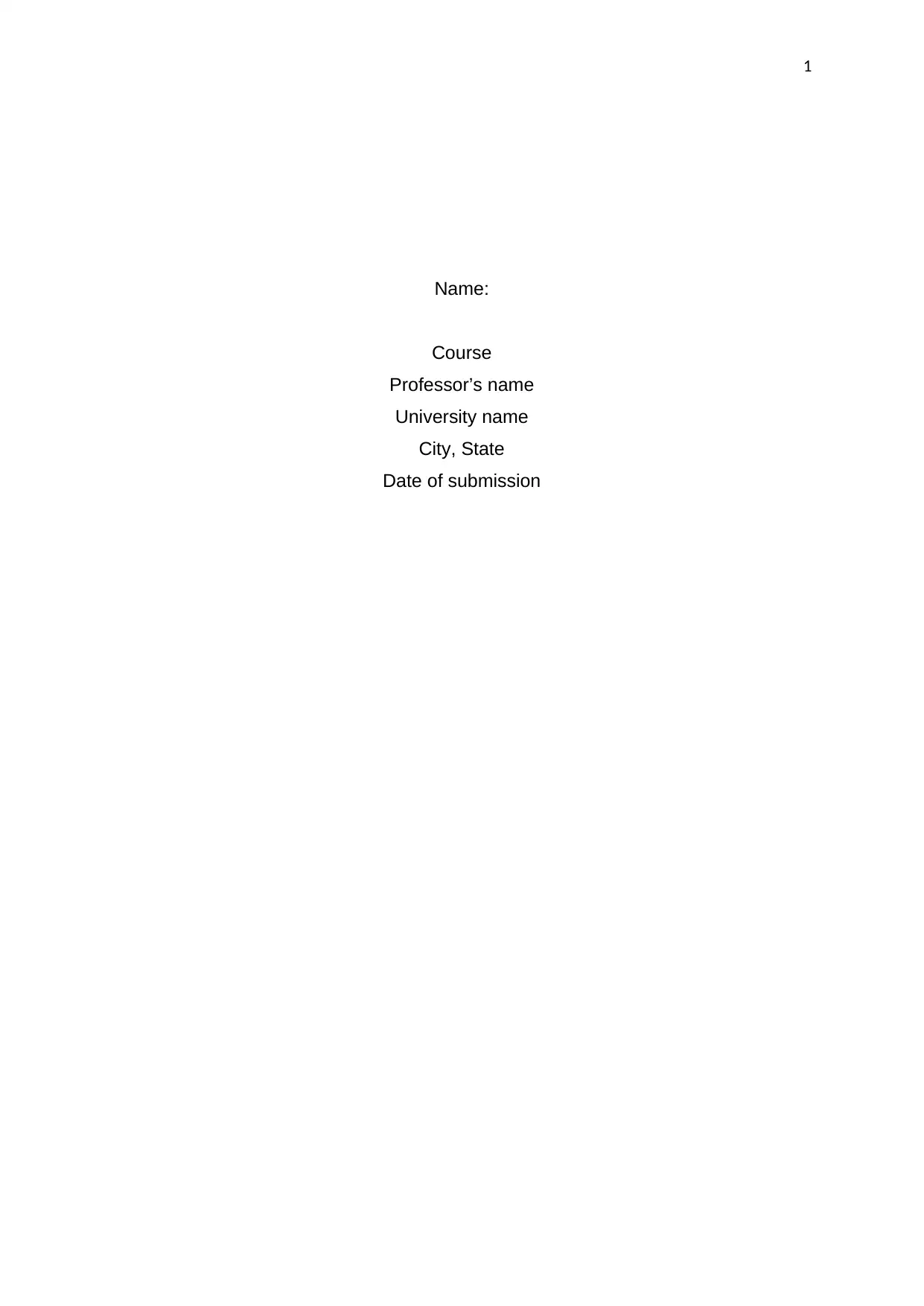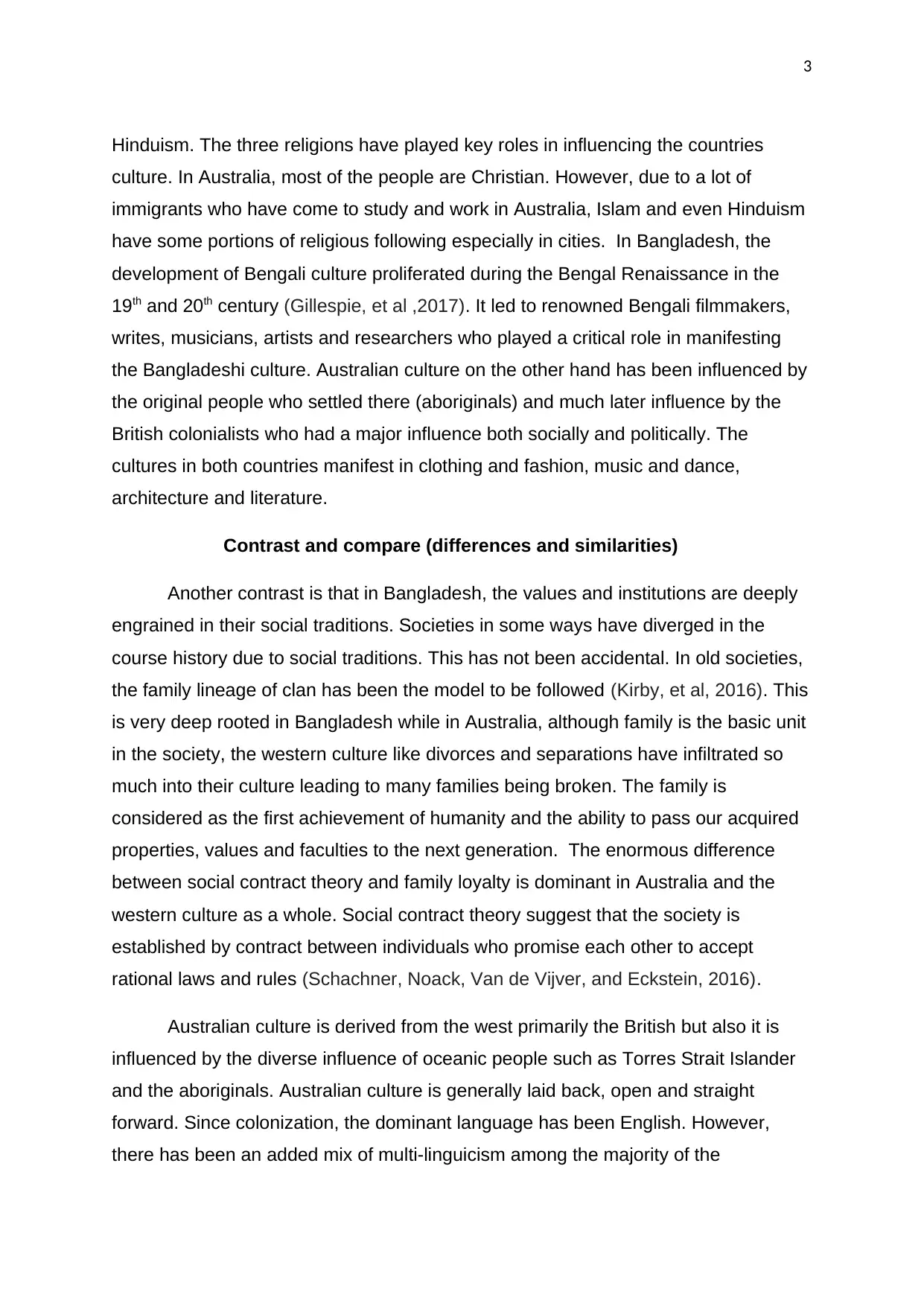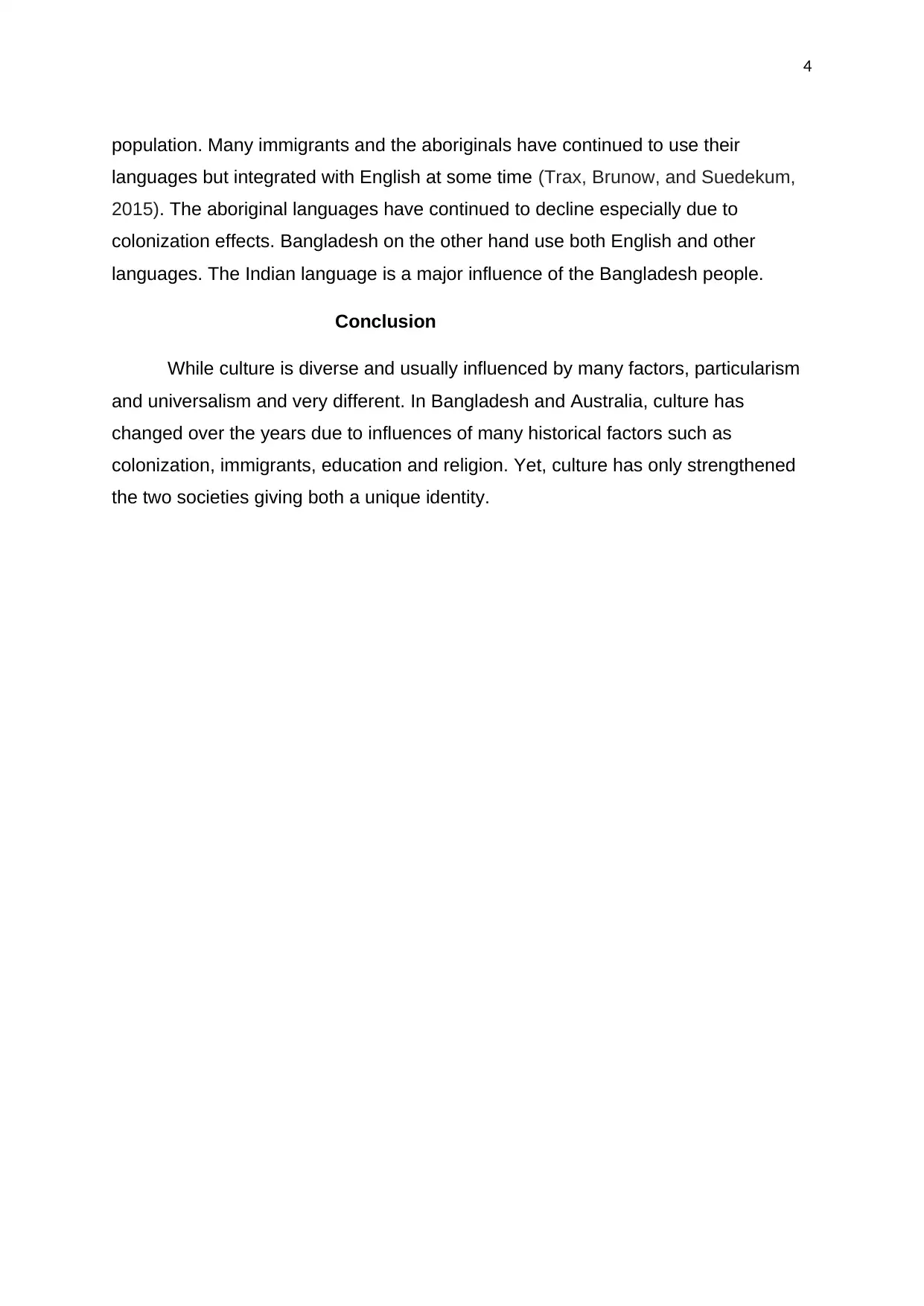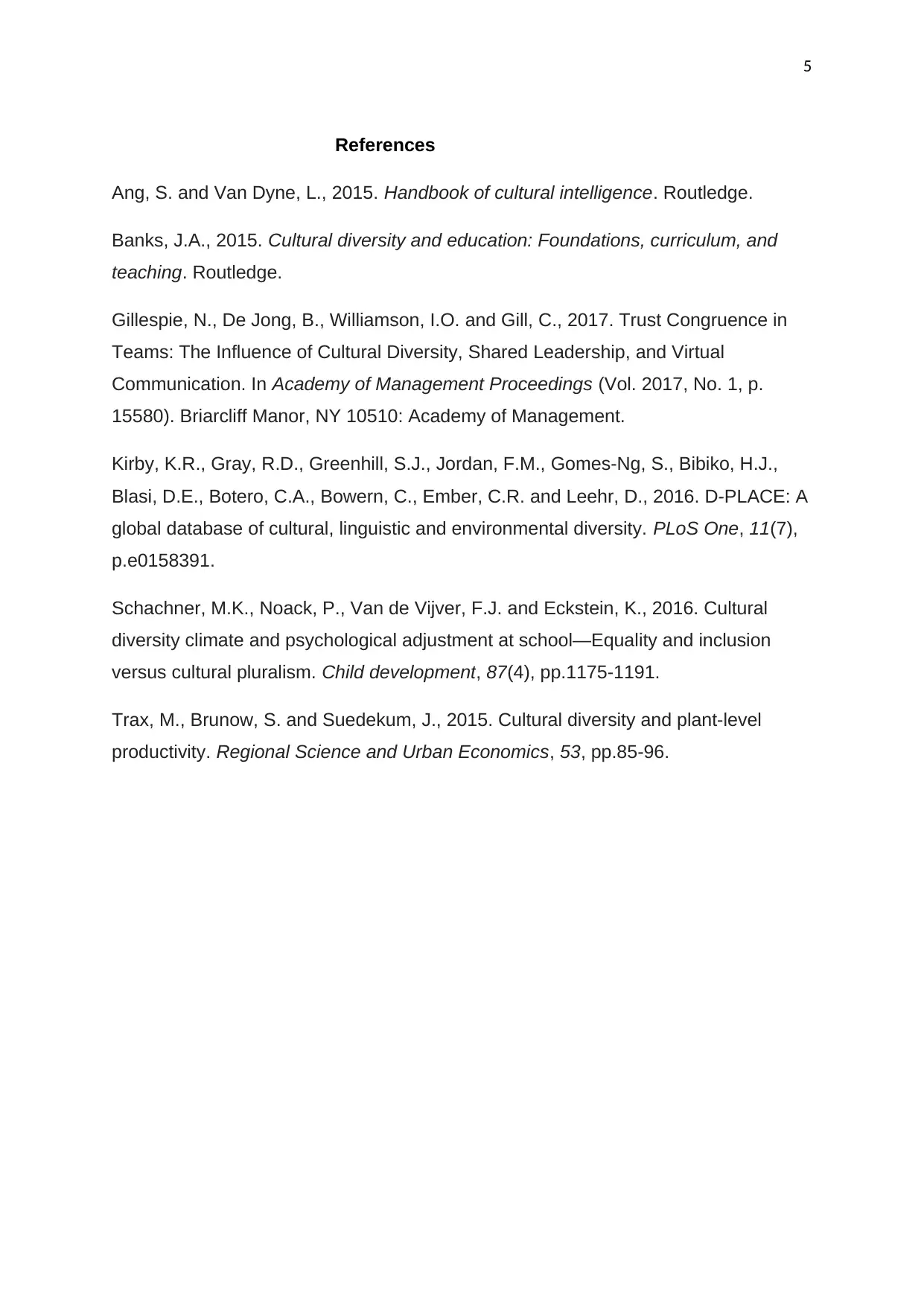Assessment 1: Comparative Analysis of Cultures - Global Environment
VerifiedAdded on 2022/09/17
|5
|1193
|23
Report
AI Summary
This report presents a comparative analysis of the cultures of Australia and Bangladesh, focusing on key differences and similarities within a global context. It utilizes Hofstede's cultural dimensions, particularly contrasting universalism and particularism, to highlight societal values, family structures, and influences of religion and history on both countries. The analysis also explores the impact of colonization, immigration, and social traditions on cultural development, including language, values, and institutions. The report references academic sources to support its findings and provides insights into how these cultural aspects influence various aspects of life. It concludes by emphasizing how these cultural influences have shaped the unique identities of both societies.

1
Name:
Course
Professor’s name
University name
City, State
Date of submission
Name:
Course
Professor’s name
University name
City, State
Date of submission
Paraphrase This Document
Need a fresh take? Get an instant paraphrase of this document with our AI Paraphraser

2
Introduction
Culture is defined as a collective programming in the human mind which
differentiates and distinguishes one country, community or group from another. The
programming in the mind influences thinking patterns and way of life which attach
various aspects of life and which become embedded in our society. In this report, we
are analyzing the cultural differences using Hofstede’s framework of two countries
which is Australia and Bangladesh. Australia and Bangladesh have both similarities
and differences in their cultures. As a discipline, analysis of cultures for both
countries is based on qualitative research methods in humanities, arts, social
sciences and anthropology to collect data on cultural representations and practices
in an effort to gain understanding and knowledge (Ang, and Van Dyne, 2015).
Application of cultural frameworks
1. Particularism vs universalism or family systems
Universalism by definition is the equal treatment of everybody subject to same
rules. On the other hand, particularism means that some people are more equal than
others in a society. In Bangladesh, our culture is more skewed towards particularism
where due to the systems in place, some families are treated more equally than
other. In contrast, Australia, as a first world country applies equality in law to
everybody. Particular treatment is not a matter of the society but also a cultural
systematic enforcement over a long period of time (Banks, 2015). For example,
some families in Bangladesh have more influence than other economically, politically
and social influence. Both Australia and Bangladesh maintain rules of open
competition in economic aspects. It is more or less indicators of objective
achievement and performance. The best person should be left to do a specific job in
the spirit of competitiveness. Moral awareness should be constant in the two
countries where building trust by working with people of importance in the society is
good.
Bangladesh has diverse culture which has evolved over time with influences from
diverse social groups. The primary religion of Bangladesh is Buddhism, Islam and
Introduction
Culture is defined as a collective programming in the human mind which
differentiates and distinguishes one country, community or group from another. The
programming in the mind influences thinking patterns and way of life which attach
various aspects of life and which become embedded in our society. In this report, we
are analyzing the cultural differences using Hofstede’s framework of two countries
which is Australia and Bangladesh. Australia and Bangladesh have both similarities
and differences in their cultures. As a discipline, analysis of cultures for both
countries is based on qualitative research methods in humanities, arts, social
sciences and anthropology to collect data on cultural representations and practices
in an effort to gain understanding and knowledge (Ang, and Van Dyne, 2015).
Application of cultural frameworks
1. Particularism vs universalism or family systems
Universalism by definition is the equal treatment of everybody subject to same
rules. On the other hand, particularism means that some people are more equal than
others in a society. In Bangladesh, our culture is more skewed towards particularism
where due to the systems in place, some families are treated more equally than
other. In contrast, Australia, as a first world country applies equality in law to
everybody. Particular treatment is not a matter of the society but also a cultural
systematic enforcement over a long period of time (Banks, 2015). For example,
some families in Bangladesh have more influence than other economically, politically
and social influence. Both Australia and Bangladesh maintain rules of open
competition in economic aspects. It is more or less indicators of objective
achievement and performance. The best person should be left to do a specific job in
the spirit of competitiveness. Moral awareness should be constant in the two
countries where building trust by working with people of importance in the society is
good.
Bangladesh has diverse culture which has evolved over time with influences from
diverse social groups. The primary religion of Bangladesh is Buddhism, Islam and

3
Hinduism. The three religions have played key roles in influencing the countries
culture. In Australia, most of the people are Christian. However, due to a lot of
immigrants who have come to study and work in Australia, Islam and even Hinduism
have some portions of religious following especially in cities. In Bangladesh, the
development of Bengali culture proliferated during the Bengal Renaissance in the
19th and 20th century (Gillespie, et al ,2017). It led to renowned Bengali filmmakers,
writes, musicians, artists and researchers who played a critical role in manifesting
the Bangladeshi culture. Australian culture on the other hand has been influenced by
the original people who settled there (aboriginals) and much later influence by the
British colonialists who had a major influence both socially and politically. The
cultures in both countries manifest in clothing and fashion, music and dance,
architecture and literature.
Contrast and compare (differences and similarities)
Another contrast is that in Bangladesh, the values and institutions are deeply
engrained in their social traditions. Societies in some ways have diverged in the
course history due to social traditions. This has not been accidental. In old societies,
the family lineage of clan has been the model to be followed (Kirby, et al, 2016). This
is very deep rooted in Bangladesh while in Australia, although family is the basic unit
in the society, the western culture like divorces and separations have infiltrated so
much into their culture leading to many families being broken. The family is
considered as the first achievement of humanity and the ability to pass our acquired
properties, values and faculties to the next generation. The enormous difference
between social contract theory and family loyalty is dominant in Australia and the
western culture as a whole. Social contract theory suggest that the society is
established by contract between individuals who promise each other to accept
rational laws and rules (Schachner, Noack, Van de Vijver, and Eckstein, 2016).
Australian culture is derived from the west primarily the British but also it is
influenced by the diverse influence of oceanic people such as Torres Strait Islander
and the aboriginals. Australian culture is generally laid back, open and straight
forward. Since colonization, the dominant language has been English. However,
there has been an added mix of multi-linguicism among the majority of the
Hinduism. The three religions have played key roles in influencing the countries
culture. In Australia, most of the people are Christian. However, due to a lot of
immigrants who have come to study and work in Australia, Islam and even Hinduism
have some portions of religious following especially in cities. In Bangladesh, the
development of Bengali culture proliferated during the Bengal Renaissance in the
19th and 20th century (Gillespie, et al ,2017). It led to renowned Bengali filmmakers,
writes, musicians, artists and researchers who played a critical role in manifesting
the Bangladeshi culture. Australian culture on the other hand has been influenced by
the original people who settled there (aboriginals) and much later influence by the
British colonialists who had a major influence both socially and politically. The
cultures in both countries manifest in clothing and fashion, music and dance,
architecture and literature.
Contrast and compare (differences and similarities)
Another contrast is that in Bangladesh, the values and institutions are deeply
engrained in their social traditions. Societies in some ways have diverged in the
course history due to social traditions. This has not been accidental. In old societies,
the family lineage of clan has been the model to be followed (Kirby, et al, 2016). This
is very deep rooted in Bangladesh while in Australia, although family is the basic unit
in the society, the western culture like divorces and separations have infiltrated so
much into their culture leading to many families being broken. The family is
considered as the first achievement of humanity and the ability to pass our acquired
properties, values and faculties to the next generation. The enormous difference
between social contract theory and family loyalty is dominant in Australia and the
western culture as a whole. Social contract theory suggest that the society is
established by contract between individuals who promise each other to accept
rational laws and rules (Schachner, Noack, Van de Vijver, and Eckstein, 2016).
Australian culture is derived from the west primarily the British but also it is
influenced by the diverse influence of oceanic people such as Torres Strait Islander
and the aboriginals. Australian culture is generally laid back, open and straight
forward. Since colonization, the dominant language has been English. However,
there has been an added mix of multi-linguicism among the majority of the
⊘ This is a preview!⊘
Do you want full access?
Subscribe today to unlock all pages.

Trusted by 1+ million students worldwide

4
population. Many immigrants and the aboriginals have continued to use their
languages but integrated with English at some time (Trax, Brunow, and Suedekum,
2015). The aboriginal languages have continued to decline especially due to
colonization effects. Bangladesh on the other hand use both English and other
languages. The Indian language is a major influence of the Bangladesh people.
Conclusion
While culture is diverse and usually influenced by many factors, particularism
and universalism and very different. In Bangladesh and Australia, culture has
changed over the years due to influences of many historical factors such as
colonization, immigrants, education and religion. Yet, culture has only strengthened
the two societies giving both a unique identity.
population. Many immigrants and the aboriginals have continued to use their
languages but integrated with English at some time (Trax, Brunow, and Suedekum,
2015). The aboriginal languages have continued to decline especially due to
colonization effects. Bangladesh on the other hand use both English and other
languages. The Indian language is a major influence of the Bangladesh people.
Conclusion
While culture is diverse and usually influenced by many factors, particularism
and universalism and very different. In Bangladesh and Australia, culture has
changed over the years due to influences of many historical factors such as
colonization, immigrants, education and religion. Yet, culture has only strengthened
the two societies giving both a unique identity.
Paraphrase This Document
Need a fresh take? Get an instant paraphrase of this document with our AI Paraphraser

5
References
Ang, S. and Van Dyne, L., 2015. Handbook of cultural intelligence. Routledge.
Banks, J.A., 2015. Cultural diversity and education: Foundations, curriculum, and
teaching. Routledge.
Gillespie, N., De Jong, B., Williamson, I.O. and Gill, C., 2017. Trust Congruence in
Teams: The Influence of Cultural Diversity, Shared Leadership, and Virtual
Communication. In Academy of Management Proceedings (Vol. 2017, No. 1, p.
15580). Briarcliff Manor, NY 10510: Academy of Management.
Kirby, K.R., Gray, R.D., Greenhill, S.J., Jordan, F.M., Gomes-Ng, S., Bibiko, H.J.,
Blasi, D.E., Botero, C.A., Bowern, C., Ember, C.R. and Leehr, D., 2016. D-PLACE: A
global database of cultural, linguistic and environmental diversity. PLoS One, 11(7),
p.e0158391.
Schachner, M.K., Noack, P., Van de Vijver, F.J. and Eckstein, K., 2016. Cultural
diversity climate and psychological adjustment at school—Equality and inclusion
versus cultural pluralism. Child development, 87(4), pp.1175-1191.
Trax, M., Brunow, S. and Suedekum, J., 2015. Cultural diversity and plant-level
productivity. Regional Science and Urban Economics, 53, pp.85-96.
References
Ang, S. and Van Dyne, L., 2015. Handbook of cultural intelligence. Routledge.
Banks, J.A., 2015. Cultural diversity and education: Foundations, curriculum, and
teaching. Routledge.
Gillespie, N., De Jong, B., Williamson, I.O. and Gill, C., 2017. Trust Congruence in
Teams: The Influence of Cultural Diversity, Shared Leadership, and Virtual
Communication. In Academy of Management Proceedings (Vol. 2017, No. 1, p.
15580). Briarcliff Manor, NY 10510: Academy of Management.
Kirby, K.R., Gray, R.D., Greenhill, S.J., Jordan, F.M., Gomes-Ng, S., Bibiko, H.J.,
Blasi, D.E., Botero, C.A., Bowern, C., Ember, C.R. and Leehr, D., 2016. D-PLACE: A
global database of cultural, linguistic and environmental diversity. PLoS One, 11(7),
p.e0158391.
Schachner, M.K., Noack, P., Van de Vijver, F.J. and Eckstein, K., 2016. Cultural
diversity climate and psychological adjustment at school—Equality and inclusion
versus cultural pluralism. Child development, 87(4), pp.1175-1191.
Trax, M., Brunow, S. and Suedekum, J., 2015. Cultural diversity and plant-level
productivity. Regional Science and Urban Economics, 53, pp.85-96.
1 out of 5
Related Documents
Your All-in-One AI-Powered Toolkit for Academic Success.
+13062052269
info@desklib.com
Available 24*7 on WhatsApp / Email
![[object Object]](/_next/static/media/star-bottom.7253800d.svg)
Unlock your academic potential
Copyright © 2020–2025 A2Z Services. All Rights Reserved. Developed and managed by ZUCOL.





